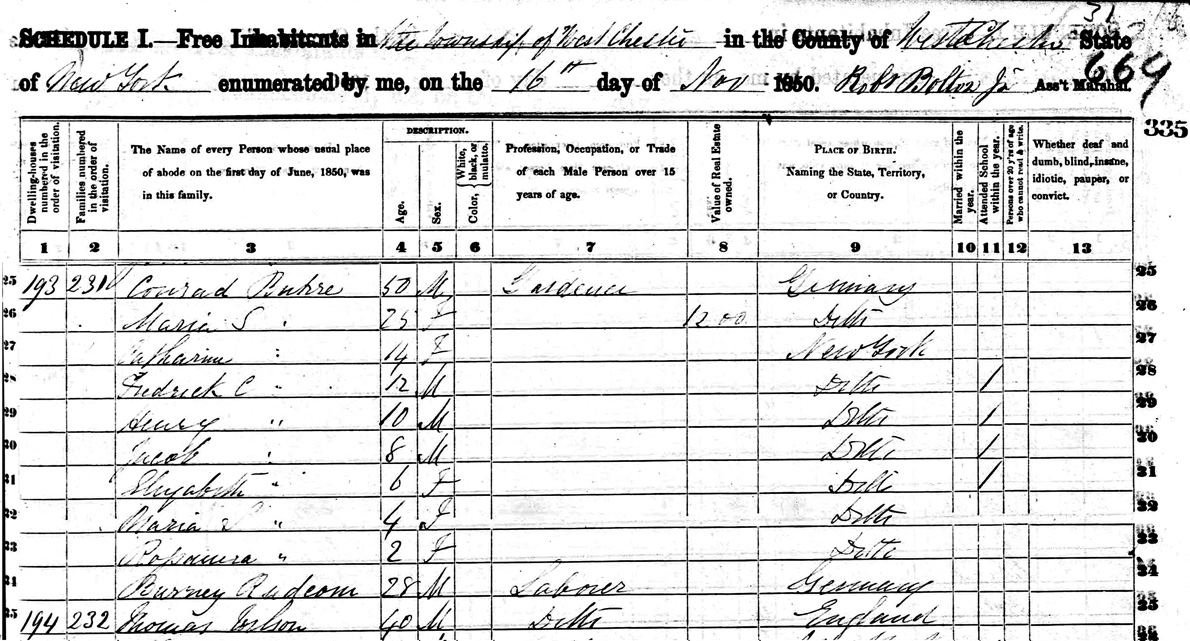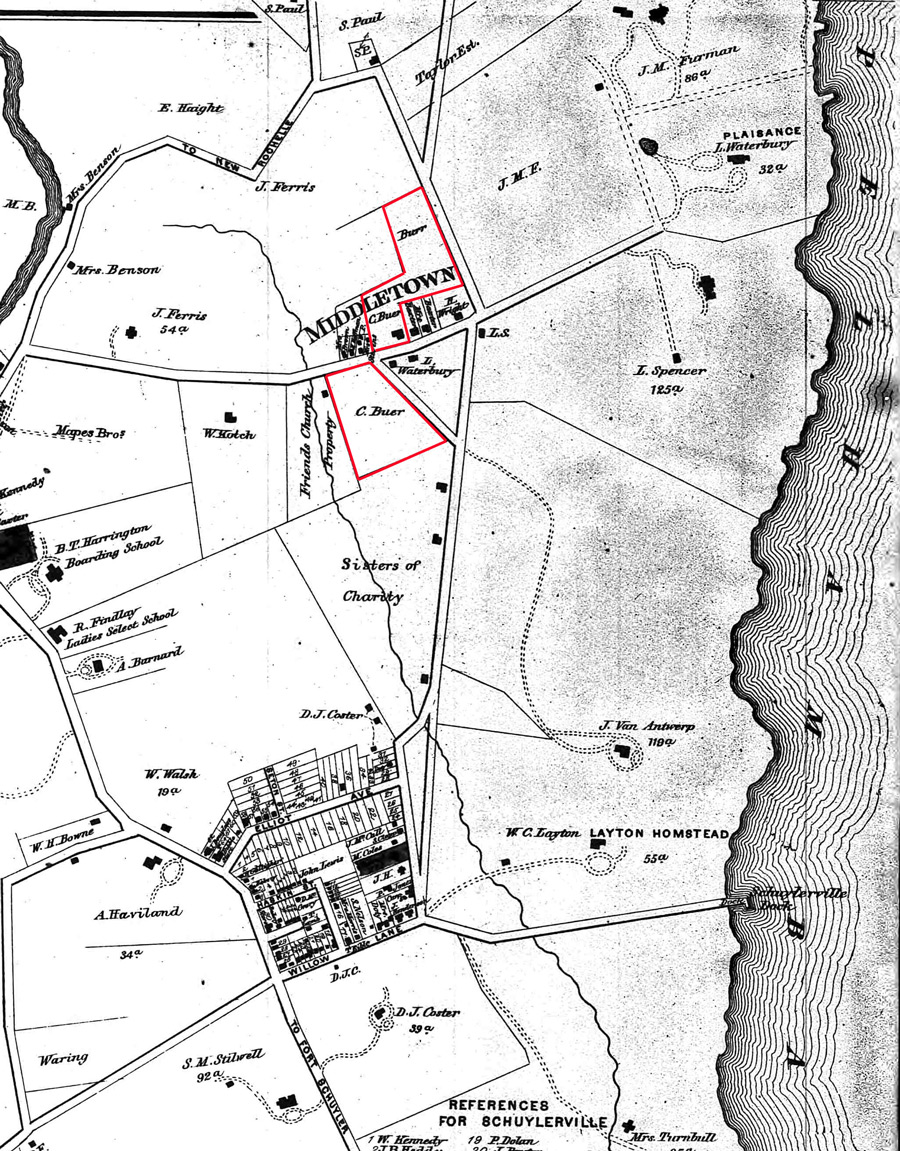The Immigration story of Bernard
Rottkamp to America.
(In Memory of the Work of Josephine Fausner Seidler)
Bernard Rottkamp left the port of Bremen, Germany on March 29, 1847 for America after traveling there from his native village Großneder in the then province of Westphalia.
He departed Bremen at a time when the immigrant trail from Germany to America was still relatively unshaped, unregulated and filled with strenuous trials. At best, he might have been enticed and advised in Germany by the German Immigrant Society of New York, a recruitment and service organization reflecting the pre-eminent presence of German ancestral populations, some only English speaking, some only German speaking as well as those bi-lingual in New York. The German presence and their institutions, concentrated in the lower reaches of Manhattan, often facilitated the arrival of new and weary immigrants like Bernard Rottkamp.
Just a few years later German port emigrés would rail transit through Scotland and England to shorten the sea going voyage. They would process through immigration and travel facilities that would shorten the trip time, affford some modicum of food and shelter services, minimize the possibility of rejection or incarceration in New York for disease, criminiality or pauperism, and allow transport on larger ships with more improved "steerage" conditions.
This improved circumstance reflected the development and operation by the New York State Commissioners' of Emigration Castle Garden reception center at the Battery in Manhattan (still preserved in 2010) from 1855-1890 at the Battery in lower Manhattan. It also signaled the development of the "immigration industry", one of the first "global industries" of modern times.
Castle Garden provided social services such as money exchange, baggage handling, licensing of boarding houses, labor exchanges, as did Castle Garden's successor Ellis Island post 1890 when the Federal Government took over immigration processing and regulation completely.
But Bernard's emigration was taken under the most trying of Atlantic crossing conditions. Ships leaving Bremen were among the smallest ocean going vessels compared to ships from deepwater ports Liverpool and Southampton in England because of preliminary river navigation along the Weser river that was required.
 Page 1 of passenger list showing Brig Roland (Rahtjen -Master from Bremen burthen 49 tons) |
Whereas passenger ships of the time from England would disembark 400+ passengers in New York, Bernard traveled in the company of 107 other souls, all in steerage, on that long voyage. Without cabin or second class, Bernard's ship was originally designed for only trade and not passengers.
 Page 4 of passenger list showing Brnh. Rotkamp (age 24, m=male, "=ditto occupation mechanic) |
Although the Brig Roland could hold more passengers than were on Bernard's trip, crowded conditions were the norm for the era. Disease spread (e.g. cholera) and numerous deaths were notorious occurrences on immigrant voyages of the time.
After a difficult and "long" period of journeying in "steerage" for 36 days on a relatively small brig for an ocean voyage, he arrived at the port of New York on May 4, 1847. In bad weather, another ten days could have been added; and if another East Coast port of call like Baltimore or Charleston were scheduled, life aboard ship could extend to 80 days. Relative to other passages of the time, he was at the average for onboard time.
His disembarkation would have been relatively simple. Only New York State laws required the identifcation of immigrants to the United States at the time of arrival by the ships Master. The Master had to pay $1.25 per capita "hospital fee" to New York for care to sick new immigrants. The Master was entitled to collect such a head tax from the passengers and one could presume it was part of the fare before boarding.
For the United States Government, all that was required was a customs declaration on freight for the collection of Federal revenue. In this case, the firm of J. C. Muller of New York received merchandise from Germany as it did regularly from ships out of Bremen.
Without the regulated money exhange, labor exchanges to protect new immigrants from enterprising bosses seeking the cheapest of labor, potential temporary medical care and the information function that Castle Garden was to later offer new arrivals, the disembarking immigrant like Bernard Rottkamp was on his own.
Where to go? Paid street promoters (shills and hucksters, otherwise) awaited the new arrivals to "guide, suggest, direct, or take" them to exploitative and expensive boarding houses. Pickpockets and swindlers among the vagabond class abounded to take what little money the immigrant had. Promises, often empty, by prospective employers and their agents were offered.
How to eat? A family oral tradition from Elizabeth Rottkamp Froehlich passed to her daughter Teresa Froehlich Wesnofske and told to the writer about 1952 was that upon arrival, Bernard sought to find something to eat.
(If another oral tradition is to be believed (and hard to believe), Bernard spoke only German even at the time of his 1851 wedding to Caroline. In all liklihood, what was described took place in one of the many German beer establishments concentrated among the substantial German population in what is today lower Manhattan.)
Seeking food, it is told, he entered an establishment and put down his German coins to establish his bona fides to pay.
The bartender seeing his German money said no to his request for food. Bernard left.
At the next establishment, he ordered his food without showing his coins. He was rewarded with his meal and the establishment management had to take his German money in payment.
Thus of experience is wisdom born for those who are hungry.
His immediate job or jobs are not known. Family tradition has at one point in time Bernard as a farm worker on a farm at Astor Place at the time of his marriage in 1851. Maps of the Astor Place area of 1852-3 show concentrated building development and residential housing for New York's upper class. Newspaper stories of the time talk of the entertainments and business of the area. It was a most unlikely place for multi-acre farming in 1851; this places this family story in grave doubt. It was much more probably for him to be a factory worker in the area than a farmer laborer. Perhaps Bernard's movement to an Astoria Post Office location in 1860 created confusion for the family folklore on this matter.
He did work on an established farm of an earlier German immigrant named Conrad Buhre in Westchester County in 1850 enumerated in the Census of 1850 as "Barney Rudcom". The development of the Harlem River Rail Road connected the population and markets of lower Manhattan to the land immediately across the Harlem River in the then Westchester County. This was important for feeding the growing population of lower New York in the 1850's. A similar story would eventually apply for the agricultural land across the East River in Queens and Brooklyn served by ferries. The ferries would later be used in the 1850's by Bernard as a Queens County farmer to sell his farmer's produce.
 |
ABOVE: 1850 Census page section listing the Family of Conrad Buhre (var. Buer) with a German farm laborer 28 yo Bernard Rottkamp listed as 'Barney Rudcom'. |
|
The Buhre farm outlined in red was located off Westchester Avenue close to the current
Pelham Bay Park in what is today the
Bronx. We know the area by a more contemporary name of Throg's Neck and today's Westchester Avenue is accessed in the Borough of the Bronx by taking the first local westbound exit on the Cross Bronx Expressway after crossing the Throg's Neck Bridge. |
 |
Portions of Westchester County were annexed sequentially by New York County as it sought pure water supplies and then by New York City as the City was consolidated in 1898. Subsquently, the Borough of the Bronx/Bronx County (the last county to be formed in New York State) was separated from New York County/Borough of Manhattan. This boundary puzzle makes for a striking historical comment that Bernard Rottkamp worked on a farm in Westchester County.
Bernard's marriage in July 1851 and movement from New York out into Astoria Queens and then to Foster's Meadow in 1861 are stories for other pages in the Rottkamp saga.
©2011 Edward R. Wesnofske P.O. Box 3029, Bridgehampton, NY 11932
Email: edwesnofske@optimum.net